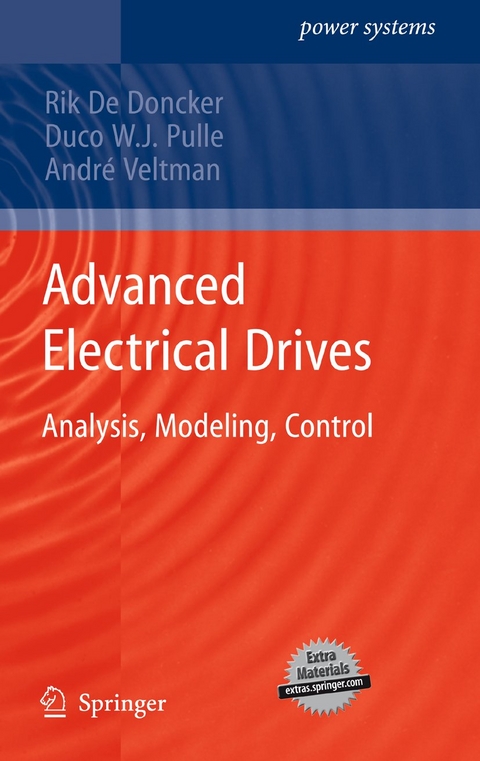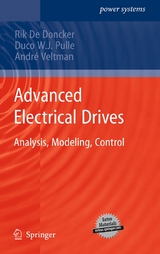Advanced Electrical Drives
Springer (Verlag)
978-94-007-0179-3 (ISBN)
- Titel erscheint in neuer Auflage
- Artikel merken
Most drives can operate in motoring and generating mode. Wind turbines use electrical drives to convert wind energy into electrical energy. More and more, variable speed drives are used to save energy for example, in air-conditioning units, compressors, blowers, pumps and home appliances.
Key to ensure stable operation of a drive in the aforementioned applications are torque control algorithms. In Advanced Electrical Drives, a unique approach is followed to derive model based torque controllers for all types of Lorentz force machines, i.e. DC, synchronous and induction machines. The rotating transformer model forms the basis for this generalized modeling approach that ultimately leads to the development of universal field-oriented control algorithms. In case of switched reluctance machines, torque observers are proposed to implement direct torque algorithms.
From a didactic viewpoint, tutorials are included at the end of each chapter. The reader is encouraged to execute these tutorials to familiarize him or herself with all aspects of drive technology. Hence, Advanced Electrical Drives encourages “learning by doing”. Furthermore, the experienced drive specialist may find the simulation tools useful to design high-performance controllers for all sorts of electrical drives.
Rik W. De Doncker (M'87 SM'99 F'01) received his Ph.D. degree (summa cum laude) in electrical engineering from the Katholieke Universiteit Leuven, Leuven, Belgium in 1986. In 1987, he was appointed a Visiting Associate Professor at the University of Wisconsin, Madison, where he lectured and conducted research on high-performance induction motor drives. In 1988, he was a General Electric Company Fellow in the microelectronic center, IMEC, Leuven, Belgium. In December 1988, he joined the General Electric Company Corporate Research and Development Center, Schenectady, NY, where he led research on drives and high-power soft-switching converters, ranging from 100 kW to 4 MW, for aerospace, industrial, and traction applications. In November 1994, he joined Silicon Power Corporation (formerly GE-SPCO) as Vice President, Technology. He worked on high-power converter systems and MTO devices and was responsible for the development and production of a 15-kV medium-voltage thyristor based transfer switch. Since October 1996, he has been a professor at Aachen University of Technology, Aachen, Germany, where he leads the Institute for Power Electronics and Electrical Drives. In Oct. 2006 he was also appointed director of the E.ON Energy Research Center at RWTH Aachen University, where he leads the Institute for Power Generation and Storage Systems. He has published over 170 technical papers and is holder of 25 patents, with several pending. Currently, Dr. De Doncker is member of the Board of the German engineering Society VDE-ETG. He is past president of the IEEE Power Electronics Society (PELS). He is member of the EPE Executive Council. He was founding Chairman of the German IEEE IAS-PELS Joint Chapter. Dr. De Doncker is recipient of the IAS Outstanding Achievements Award and the IEEE Power Engineering Custom Power Award (2008).
1 Modern electrical drives: an overview. 1.1 Introduction. 1.2 Drive technology trends. 1.3 Drive design methodology. 1.4 Experimental setup.
2 Modulation techniques for power electronic converters. 2.1 Introduction. 2.2 Single-phase half-bridge converter. 2.3 Single-phase full-bridge converter. 2.4 Three-phase converter. 2.5 Dead-time effects. 2.6 Tutorials.
3 Current control of generalized load. 3.1 Current control of single-phase load. 3.2 Current control of a three-phase load. 3.3 Tutorials.
4 Drive principles. 4.1 ITF and IRTF concepts. 4.2 Electromagnetic torque control principles. 4.3 Drive dynamics. 4.4 Shaft speed control loop design principles. 4.5 Tutorials.
5 Modeling and control of DC machines. 5.1 Separately excited, current-controlled DC machine. 5.2 Field-oriented machine model. 5.3 Control of separately excited DC machines. 5.4 Tutorials.
6 Synchronous machine modeling concepts. 6.1 Non-salient machine. 6.2 Salient synchronous machine. 6.3 Tutorials.
7 Control of synchronous machine drives. 7.1 Controller principles. 7.2 Control of non-salient synchronous machines. 7.3 Control of salient synchronous machines. 7.4 Field-oriented control of a current-controlled synchronous machine. 7.5 Field-oriented control of a voltage-source connected synchronous machine. 7.6 Tutorials.
8 Induction machine modeling concepts. 8.1 Induction machine with squirrel-cage rotor. 8.2 Zero leakage inductance models of induction machines. 8.3 Machine models with leakage inductances. 8.4 Parameter identification and estimates for stator and rotor flux linkage magnitude. 8.5 Single-phase induction machines. 8.6 Tutorials.
9 Control of induction machine drives. 9.1 Voltage-to-frequency (V/f) control. 9.2 Field-oriented control. 9.3 Operational drive boundaries for rotor flux oriented control. 9.4 Field weakening for rotor flux oriented IM drives. 9.5 Interfacing FOC with current-controlled IM. 9.6 Interfacing FOC with voltage-source-connected IM. 9.7 Tutorials.
10 Switched reluctance drive systems. 10.1 Basic machine concepts. 10.2 Operating principles. 10.3 Multi-phase machines. 10.4 Control of switched reluctance drives. 10.5 Switched reluctance demonstration machine. 10.6 Tutorials.
References. Abbreviations. List of symbols. List of indices. Index.
| Reihe/Serie | Power Systems |
|---|---|
| Zusatzinfo | 343 Illustrations, color; XVIII, 462 p. 343 illus. in color. With online files/update. |
| Verlagsort | Dordrecht |
| Sprache | englisch |
| Maße | 155 x 235 mm |
| Gewicht | 1340 g |
| Themenwelt | Informatik ► Theorie / Studium ► Künstliche Intelligenz / Robotik |
| Technik ► Elektrotechnik / Energietechnik | |
| Schlagworte | Control • electrical drives • Mechatronics • Power Systems |
| ISBN-10 | 94-007-0179-9 / 9400701799 |
| ISBN-13 | 978-94-007-0179-3 / 9789400701793 |
| Zustand | Neuware |
| Haben Sie eine Frage zum Produkt? |
aus dem Bereich





